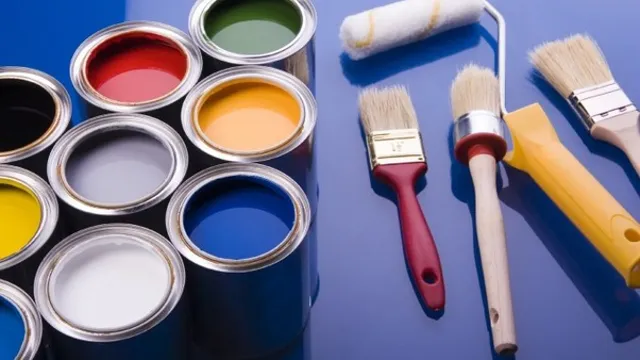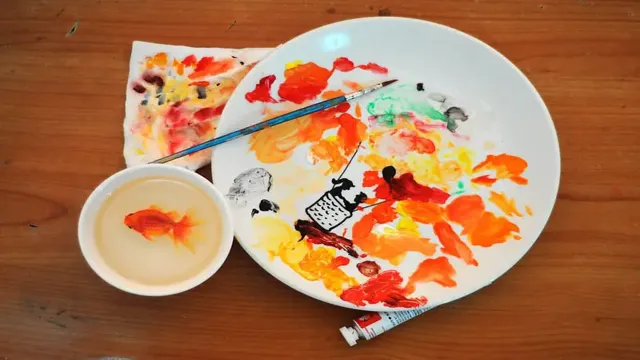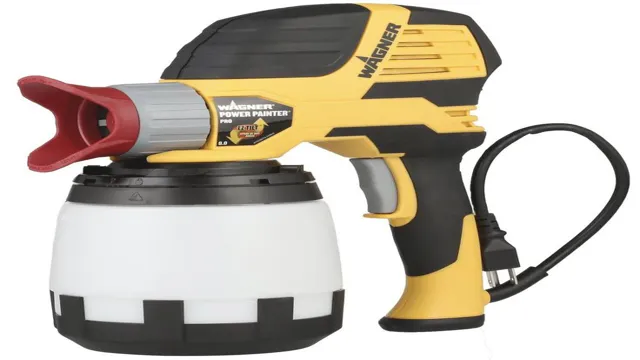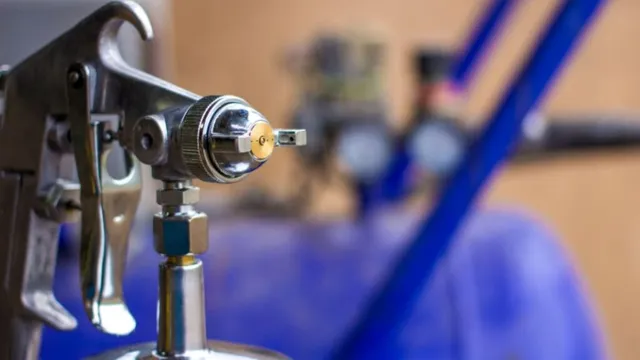Can You Use Acrylic Paint in a Paint Sprayer? Tips and Tricks for Successful Spraying

Have you ever tried using acrylic paint in a paint sprayer? It may seem like an unconventional combination, but it can actually produce some stunning results. Acrylic paint is typically used for painting on canvas or paper, but it can also be used on a variety of surfaces, including wood, metal, and even plastic. When paired with a paint sprayer, acrylic paint can create a smooth and even finish on any surface.
In this blog, we’ll discuss the benefits of using acrylic paint in a paint sprayer, and provide some tips and tricks for achieving the best results. So, whether you’re a professional painter or a DIY enthusiast, let’s dive in and explore the world of acrylic paint and paint sprayers!
Understanding Acrylic Paint
Yes, you can use acrylic paint in a paint sprayer. In fact, many DIY enthusiasts and professional painters prefer to use acrylic paint because of its easy clean-up and quick drying time. However, it’s important to note that not all paint sprayers are created equal, and some may not be compatible with acrylic paint.
To ensure the best results, it’s important to choose a paint sprayer that has been designed specifically for use with acrylic paint. Additionally, it’s important to properly thin the paint before using it in a sprayer, as thick paint can clog the nozzle and prevent a smooth application. Overall, when used correctly, acrylic paint can produce a beautiful, even finish when applied through a paint sprayer.
Composition and Properties of Acrylic Paint
Acrylic paint is a popular medium amongst artists due to its versatility and durability. It is made up of pigment suspended in a water-based acrylic polymer emulsion. The polymer acts as a binder, holding the pigment particles together and allowing them to adhere to a variety of surfaces such as canvas, paper, and wood.
The paint can be thinned down with water or mixed with other acrylic mediums to create a range of effects, from transparent washes to thick impasto textures. One of the benefits of acrylic paint is its quick drying time, which allows for layering and adding further details without having to wait long periods of drying time. Additionally, acrylic paint is known for its resistance to fading and yellowing over time, making it a popular choice for painting in the modern era.

Benefits of Using Acrylic Paint
Acrylic paint is a versatile painting medium that has become increasingly popular among artists and hobbyists in recent years. Understanding the benefits of this type of paint is key to unlocking its full potential. Acrylic paint dries more quickly than other types of paint, which means the artist can work faster and create more layers of color and texture in a shorter amount of time.
Additionally, acrylic paint is water-soluble, making it easy to clean up with just soap and water. This is great news for those who don’t want to deal with noxious chemicals or fumes when working on their art. Another advantage of acrylic paint is its ability to create a range of effects, from opaque and glossy to transparent and matte.
This makes it a versatile choice for artists who want to experiment with different techniques and styles. Overall, acrylic paint is a fantastic choice for anyone who wants to create vibrant, colorful art with a medium that is easy to work with and offers endless possibilities.
Using a Paint Sprayer with Acrylic Paint
Yes, you can use acrylic paint in a paint sprayer. Using a paint sprayer with acrylic paint can make your DIY projects and painting jobs easier, faster, and more efficient. However, it is important to note that not all paint sprayers are created equal with regards to handling acrylic paint.
You need to make sure that you choose a paint sprayer that is specifically designed for use with acrylic paint to ensure the best results. Acrylic paint can be thick and viscous, which is why it is important to choose a paint sprayer that can handle this type of paint. Additionally, you should make sure that the acrylic paint is properly thinned before using it in the paint sprayer.
Thinning the paint can help to prevent clogging and ensure that the paint sprays evenly and smoothly. With the right paint sprayer and proper techniques, you can achieve professional-looking results and complete your painting projects quickly and efficiently.
Types of Paint Sprayers
If you’re working with acrylic paint, you’ll want to make sure you’re using the right type of paint sprayer. One of the best options for working with acrylic paint is an airless paint sprayer, as it can handle the thicker consistency of acrylic paint and produce a smooth, even finish. HVLP (high-volume, low-pressure) paint sprayers can also work with acrylic paint, but they require more thinning than airless sprayers and may not provide as smooth of a finish.
When using a paint sprayer with acrylic paint, it’s important to properly thin the paint and clean the sprayer thoroughly after use to prevent clogs and ensure longevity of the equipment. With the right prep and equipment, using a paint sprayer with acrylic paint can save time and provide a professional-quality finish to your project.
Prepping the Paint and Sprayer
Prepping the Paint and Sprayer is an essential step when using a paint sprayer with acrylic paint. Firstly, it is important to choose a sprayer that is compatible with acrylics as some can clog or wear out. Next, you need to prepare the paint for spraying.
Diluting the acrylic paint with water until it is the consistency of milk is a good rule of thumb. This allows the paint to easily flow through the sprayer without clogging the nozzle. It is also important to strain the paint to remove any impurities that could clog the sprayer or affect the finish.
Once the paint is ready, you must clean the sprayer according to the manufacturer’s instructions before filling it with paint. This ensures that there is no residue left from past uses which can mix with the new colour and affect the outcome. Taking these steps will help you achieve a beautiful and consistent finish when using a paint sprayer with acrylic paint.
Settings and Techniques to Use with Acrylic Paint
When it comes to using a paint sprayer with acrylic paint, there are a few things to consider. First, it’s important to make sure that your paint sprayer is compatible with acrylics. Some sprayers may not work well with thinned paint or may require additional equipment to properly spray acrylics.
Once you have a compatible sprayer, it’s important to properly thin your acrylic paint to the correct consistency for spraying. Too thin and the paint may run or splatter, while too thick paint may clog the sprayer. Additionally, always wear protective gear when using a paint sprayer, such as a mask and goggles.
This will ensure that no harmful chemical particles are inhaled or get into your eyes. Lastly, practice makes perfect when it comes to using a paint sprayer with acrylic paint. Start with smaller projects before moving onto larger ones to get a better feel for how your sprayer handles the paint.
With these tips, you’ll have no trouble achieving a smooth, even finish with your acrylic paint sprayer.
Tips and Best Practices for Using Acrylic Paint in a Sprayer
If you are wondering whether it is possible to use acrylic paint in a paint sprayer, the answer is yes, you definitely can. In fact, using acrylic paint in a sprayer can give your project a smooth finish and make the process a lot easier and faster. However, there are certain tips and best practices that you need to follow to ensure that your spray painting experience with acrylic paint is successful.
Firstly, it is essential to thin the paint before using it in the sprayer. This will make it easier to spray and avoid clogging issues. Secondly, always ensure that you protect your working area, clothing, and skin from overspray.
You can do this by wearing a mask, gloves, and protective clothing such as aprons. Lastly, make sure you clean the sprayer correctly after every session to prolong its life and prevent clogging. Overall, using acrylic paint in a sprayer can produce fantastic results, and by following these tips and best practices, your paint job can be flawless.
So, what are you waiting for? Grab your paint sprayer and get to work!
Maintaining and Cleaning the Sprayer After Use
Maintaining and Cleaning the Sprayer After Use Acrylic paint can be a great way to give your projects a professional and modern look. When using a sprayer to apply the paint, it’s important to keep a few things in mind to ensure the best results. First of all, it’s important to choose the right type of paint for your sprayer.
Acrylic paints work well with sprayers because they’re thin enough to flow through the nozzle without clogging and can be easily sprayed onto a variety of surfaces. To get the best results, it’s important to keep your sprayer clean and well-maintained. After each use, be sure to wash out any remaining paint with warm soapy water or solvent and rinse thoroughly.
You should also periodically disassemble your sprayer to clean and replace any worn-out parts. Taking care of your sprayer will help ensure it lasts a long time and continues to provide you with great results every time you use it.
Choosing the Right Type of Acrylic Paint for Spraying
Spraying acrylic paint can be a great way to achieve a smooth, even finish on your projects. But with so many types of acrylic paint available, it’s important to choose the right one for your specific needs. For spraying, it’s best to use a paint that is thinned down to a consistency similar to milk.
This makes it easier to atomize and apply evenly through the sprayer. Additionally, look for paints that are labeled as “airbrush-ready” or “spray paint” to ensure they are designed to work well in a sprayer. Taking the time to choose the right type of acrylic paint can make all the difference in achieving a professional-looking finish on your projects.
So next time you’re at the art supply store, remember to look for these key features in your paint.
Conclusion
After all the research and consideration, it’s safe to say that you can technically use acrylic paint in a paint sprayer. However, it’s important to keep in mind that not all types of acrylic paint are compatible with sprayers and there may be limitations in terms of the quality of finish. So, if you want to paint things like a pro, it’s always best to stick to the paints that are specifically designed for spray application.
Remember, the key to a successful paint job is to be prepared and use the right tools for the job. Happy painting!”
FAQs
What is an acrylic paint?
Acrylic paint is a water-based paint that dries quickly and forms a flexible, durable film.
Can you use acrylic paint in a paint sprayer?
Yes, you can use acrylic paint in a paint sprayer, as long as the paint is thinned to the appropriate consistency.
Do you need to thin acrylic paint before using it in a paint sprayer?
Yes, you need to thin acrylic paint before using it in a paint sprayer. The exact amount of thinning required depends on the type of paint sprayer you are using.
What type of paint sprayer is best for acrylic paint?
HVLP (high volume, low pressure) paint sprayers are best for acrylic paint because they provide a fine, even spray and minimize overspray.
How do you thin acrylic paint for a paint sprayer?
To thin acrylic paint for a paint sprayer, you can use water, acrylic medium, or a combination of both. The amount of thinning required varies depending on the type of paint sprayer and the thickness of the paint.
Is it safe to use acrylic paint in a paint sprayer indoors?
Yes, it is safe to use acrylic paint in a paint sprayer indoors as long as you take appropriate safety precautions, such as wearing a respirator and ensuring adequate ventilation.
What are the benefits of using acrylic paint in a paint sprayer?
Using acrylic paint in a paint sprayer can save time, provide a smooth and even finish, and allow for greater control over the application of the paint. Additionally, acrylic paint is durable and versatile, making it suitable for a wide range of projects.



